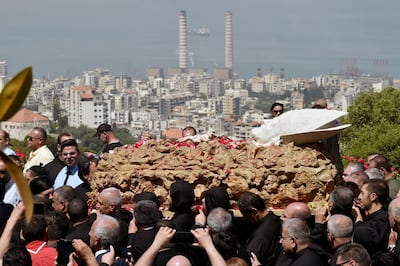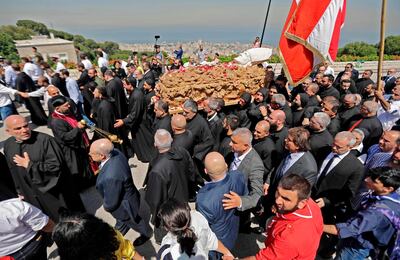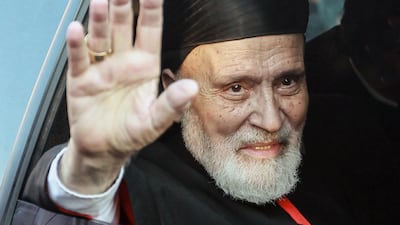The death of Nasrallah Boutros Sfeir, the former Maronite Christian patriarch, has robbed Lebanon of one of the most steadfast proponents of state integrity, at a time when the political classes are riven with conflict and the country is drifting.
While Sfeir had been out of office since 2011 and his influence had declined, he retained symbolic importance among Maronites. He helped the community navigate the two decades after the end of Lebanon’s civil war, when it faced major challenges, both in terms of political representation and internal unity. Sfeir will be remembered as a stalwart defender of Lebanese sovereignty in the era of a Syrian military presence, as well as being an indefatigable proponent of post-civil war reconciliation and coexistence.
While Sfeir headed the Maronite church, his legacy will be more political than religious. He was old school – he died at 99, the same age as modern-day Lebanon – and was not an innovator of lasting changes within the clergy. He took office in April 1986 as crises were brewing in the Christian community. Three years later the main Christian militia, the Lebanese Forces, led by Samir Geagea, fought viciously with Christian-dominated units of the Lebanese Army headed by president Michel Aoun, who then commanded the army.
With his community tearing itself apart, Sfeir supported the Taif Accord of October 1989. Its aim was to end the 14-year civil war by amending the Lebanese constitution to significantly water down the powers of the Maronite community and expand the role of Muslims. Sfeir had little choice but to go along with it, as its immediate purpose was to terminate the bloodletting among Maronites.
What Taif effectively brought about was a Saudi-Syrian agreement over Lebanon that was blessed by the US. Once the war ended in 1990, Sfeir came to play a more central role as Syria consolidated its hold over the country. With Mr Aoun in exile and Geagea imprisoned in 1994 by the pro-Syrian Lebanese authorities, he was alone in voicing the concerns of his community while calling for respect for Lebanon’s sovereignty and institutions.
His was a voice in the desert. Virtually all those in power had close ties to Damascus and Sfeir realised that his latitude to effect change was limited by the fact that he was a man of the church, presiding over a community in disarray. His sole weapon was to restate general principles about how the Lebanese state should be allowed to function, much of this undermined on a daily basis by Syrian officers, who ran Lebanon’s affairs, down to the smallest details.

In 2000, there seemed to be a narrow way out of the years of futility when Israel withdrew its military forces from southern Lebanon. With this official justification for the Syrian presence gone, the Maronite bishops, under Sfeir’s guidance, issued a statement asking for an end to Syrian tutelage over Lebanon. Yet at a time when the US and European powers were still wedded to a post-war arrangement that effectively recognised Syrian domination over Lebanon, the Maronite church made little headway.
However, in 2001, two things happened that showed how Sfeir was unwilling to be intimidated. In April, a number of prominent Christians formed the Qornet Shehwan gathering, with Sfeir’s blessing, to affirm an independent line with regard to Syria and create a base of Christian support around the Maronite patriarch’s stance. In August, Sfeir and the Druze leader Walid Jumblatt organised a reconciliation in the mountains between their respective communities, almost two decades after the Druze had expelled Christians from the area.
While Syria did not welcome these developments, seeing in them a challenge to its absolute power, it did not stop them. Perhaps both Sfeir and Mr Jumblatt calculated that the new leader in Syria, Bashar Al Assad, would allow them some breathing space. However, Mr Al Assad’s decision in 2004 to extend the term of then Lebanese president Emile Lahoud showed that he had no desire to be any more tolerant of Lebanese autonomy than his father.

In 2005, when the assassination of the former prime minister Rafic Hariri led to the withdrawal of Syrian forces from Lebanon, Sfeir was a primary mentor of the independence movement. Yet his sectarian conservatism would come to the fore when he opposed a march on the presidential palace to oust Mr Lahoud. For the Maronite patriarch, any attack on the presidency was an attack on his community, from which Lebanon’s presidents are chosen. He disappointed some followers but ultimately his decision was likely a wise one.
In light of his influence, Sfeir's decision to leave his position as patriarch seemed to come suddenly in January 2011. He was 91 at the time and it was generally understood that the Vatican wanted a younger man to head the Maronite church. The beneficiary was the present patriarch, Bishara Al Rai, who subsequently marginalised many of his predecessor's collaborators. It was all a bit unbecoming, but also predictable in a church where politics and rivalries are second nature.
With Sfeir’s death, another figure from a previous Lebanon has left us. What remains is an increasingly discredited political class and an ossified church hierarchy that provokes more ridicule than admiration. Ultimately, Sfeir might have left behind less than he hoped. His tragic flaw was having higher expectations of Lebanon and its sovereignty than those ruling over the country.
Michael Young is editor of Diwan, the blog of the Carnegie Middle East programme, in Beirut


